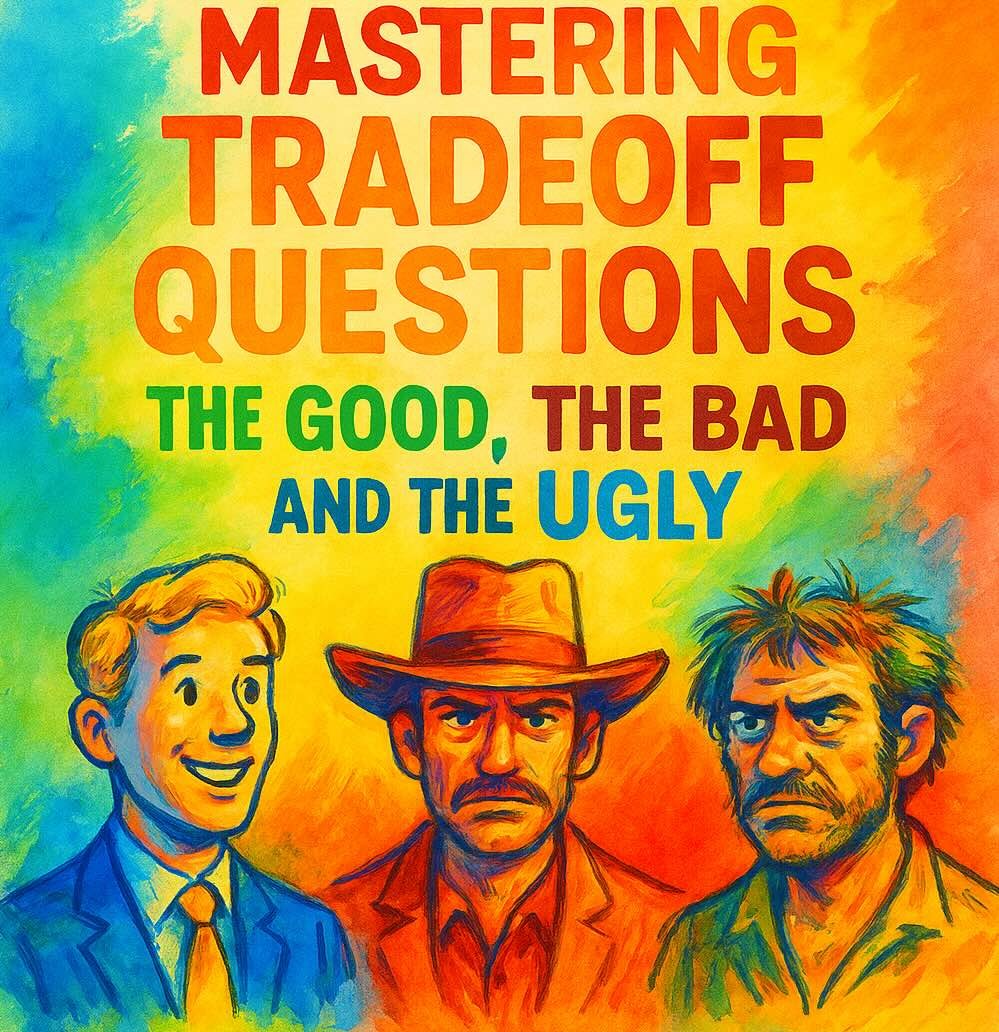Mastering Tradeoff Questions: The Good, the Bad, and the Ugly
Mark Rose
8/9/20255 min read


If you're interviewing for PM roles at Meta, Google, DoorDash, Coinbase, or Stripe, you will face tradeoff questions. They're unavoidable, high-stakes, and often make or break your interview performance. After analyzing real coaching sessions with FAANG-bound candidates, I've seen the good, the bad, and the ugly of how PMs handle these critical moments.
The ugly truth: Most candidates fail tradeoff questions not because they lack product sense, but because they approach them like tactical problems instead of strategic decisions.
The Good: How Top Candidates Think
The best PM candidates treat tradeoff questions like CEOs analyzing business decisions. They follow a clear mental model that works across all scenarios:
1. Acknowledge the Tension (Don't Rush the Answer)
"So we have WhatsApp voice calls growing—that's great. But Messenger voice calls declining—that makes me sad. We clearly have some cannibalization happening."
2. Ladder Up to Strategic Level
"The real question isn't whether to cannibalize—it's whether this is good or bad cannibalization. Let me look at this from the Meta ecosystem level."
3. Apply Clear Decision Framework
"Let's check MAU, time-on-site, and monetization across the platform. If they're all up, it's good cannibalization. If down, it's bad. If mixed, we escalate with hypotheses."
4. Make the Call
"Based on ecosystem health being positive, my recommendation is: keep driving WhatsApp growth. VP of Messenger, sorry not sorry—go fix your product."
This approach works because it demonstrates executive judgment, not just analytical skills.
The Bad: Where Candidates Go Wrong
The Analysis Paralysis Trap
What they do: Spend 10 minutes diving into detailed metrics, user segmentation, and root cause analysis.
Why it fails: Tradeoff questions test decision-making under pressure, not your ability to build perfect analytical models.
Real example: One candidate got lost calculating conversion funnels when asked about feature impact, missing the simple question: "What happened to your North Star metric?"
The False Precision Problem
What they do: Try to calculate exact percentages or provide overly specific recommendations.
Why it fails: These are strategic judgment calls, not math problems.
Coach feedback: "Don't try to defend your answer—attack it. Say 'this answer is probably totally wrong, but here's my reasoning.'"
The Tactical Thinking Trap
What they do: Focus on product-level solutions instead of business-level decisions.
Why it fails: Senior PMs need to "fly the airplane," not optimize individual components.
Real example: When told Messenger was being cannibalized, one candidate immediately started designing features to improve Messenger instead of evaluating whether cannibalization was strategically good or bad.
The Ugly: The Three Deadly Mistakes
1. Using Ratios as North Star Metrics
The mistake: "Our North Star should be match quality percentage—successful matches divided by total matches."
Why it's deadly: Ratios can stay stable while your business collapses. Your numerator and denominator can both crash, but you'll think everything's fine.
Coach's rule: "Never use a ratio as a North Star. It's always 'number go up'—always a total number."
2. The Apple-Orange Comparison
The mistake: When told Product A is cannibalizing Product B, trying to directly compare the products.
Why it's deadly: Shows you think like a feature PM, not a business leader.
The right move: "I can't compare apples and oranges. Let me go up to the platform level and see if this is good or bad for the overall business."
3. The Humble Hedging
The mistake: "Well, it depends on a lot of factors, and I'd need to gather more data to really know..."
Why it's deadly: Tradeoff questions test your ability to make decisions with incomplete information. Hedging shows you can't handle ambiguity.
What works: Make a clear call with clear reasoning, then acknowledge limitations separately.
The Three Universal Tradeoff Types
Every PM interview tradeoff question falls into one of these categories:
Type 1: The Cannibalization Question
Format: "Your product is succeeding, but it's hurting [other product]. What do you do?"
The Good: Check ecosystem-level health metrics. If Meta-level MAU/engagement/monetization are up, it's good cannibalization.
The Bad: Trying to fix both products simultaneously.
The Ugly: Comparing the products directly or getting defensive about your product's success.
Type 2: The Feature Impact Question
Format: "New feature launched. Metric A down 5%, Metric B up 10%. Keep or kill?"
The Good: "What's the impact on my North Star metric?" Make decision based on that answer.
The Bad: Trying to solve for both metrics simultaneously.
The Ugly: Ignoring your North Star and getting lost in secondary metrics.
Type 3: The Breadth vs. Depth Question
Format: "10,000 groups of 100 people vs. 100 groups of 10,000 people?"
The Good: Recognize the math is identical by design. Lean on mission and human psychology. Default to breadth (90% of the time).
The Bad: Trying to calculate engagement differences when they're designed to be equal.
The Ugly: Missing that this tests strategic thinking, not math skills.
The Meta-Skills That Matter
Strategic Altitude
Think like you're briefing the CEO, not optimizing a feature. Use phrases like:
"Taking a step back to the ecosystem level..."
"When I think about this on a first principles basis..."
"The real question is..."
Confident Decision-Making
Make clear calls even with incomplete information:
"Based on X, my recommendation is Y"
"In the short run, I'd do A. Long term, I'd revisit based on B"
"This is good/bad cannibalization because..."
Intellectual Honesty
Acknowledge limitations without hedging your decision:
"This answer is probably wrong in the details, but directionally correct"
"I'm making assumptions about X that we'd need to validate"
"There are other factors to consider, but given what we know..."
The Modern Complexity Layer
Today's PM tradeoff questions are evolving with new technologies:
AI Product Challenges
How do you know when an AI interaction is "complete"?
Traditional metrics like "clicks" don't work when answers are provided directly
Solution: Session-based metrics, AI self-evaluation, proxy indicators like daily usage
Cross-Platform Effects
Companies can now measure the "butterfly effect"—how a Messenger feature impacts Dating
Makes cannibalization questions more sophisticated and data-driven
Requires even more ecosystem-level thinking
Your Preparation Playbook
1. Master the Three-Step Framework
For any tradeoff:
Acknowledge: "We have X going up and Y going down"
Framework: "Let me check [North Star/ecosystem health/mission alignment]"
Decide: "Based on that, I recommend..."
2. Practice Executive Language
Stop saying: "It depends" or "I'd need more data" Start saying: "Based on these principles, here's my call"
3. Memorize the Meta-Patterns
Cannibalization: Go to ecosystem level
Feature impact: Check North Star
Breadth vs. depth: Lean on mission, default to breadth
Never: Use ratios as North Stars
4. Embrace the Mess
Real PM work is about making decisions with incomplete information under time pressure. These questions aren't academic exercises—they're job previews.
The Bottom Line
Tradeoff questions separate senior PMs from junior ones. They test whether you can make strategic decisions when the stakes are high and the information is incomplete. Master the frameworks, practice the meta-thinking, and remember: they're not looking for perfect answers—they're looking for executive judgment.
The good news? Once you understand the patterns, these questions become predictable. The bad news? You still have to perform under pressure. The ugly truth? Most candidates never learn these frameworks and wing it.
Don't be most candidates.
Copyright 2024. All rights reserved. Privacy Policy. Refunds and Cancelations. Terms and Conditions.


